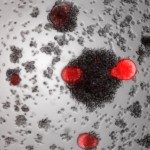Lien vers Pubmed [PMID] – 16699598
PLoS Pathog. 2006 May;2(5):e39
The human immunodeficiency virus (HIV) type-1 viral protein U (Vpu) protein enhances the release of diverse retroviruses from human, but not monkey, cells and is thought to do so by ablating a dominant restriction to particle release. Here, we determined how Vpu expression affects the subcellular distribution of HIV-1 and murine leukemia virus (MLV) Gag proteins in human cells where Vpu is, or is not, required for efficient particle release. In HeLa cells, where Vpu enhances HIV-1 and MLV release approximately 10-fold, concentrations of HIV-1 Gag and MLV Gag fused to cyan fluorescent protein (CFP) were initially detected at the plasma membrane, but then accumulated over time in early and late endosomes. Endosomal accumulation of Gag-CFP was prevented by Vpu expression and, importantly, inhibition of plasma membrane to early endosome transport by dominant negative mutants of Rab5a, dynamin, and EPS-15. Additionally, accumulation of both HIV and MLV Gag in endosomes required a functional late-budding domain. In human HOS cells, where HIV-1 and MLV release was efficient even in the absence of Vpu, Gag proteins were localized predominantly at the plasma membrane, irrespective of Vpu expression or manipulation of endocytic transport. While these data indicated that Vpu inhibits nascent virion endocytosis, Vpu did not affect transferrin endocytosis. Moreover, inhibition of endocytosis did not restore Vpu-defective HIV-1 release in HeLa cells, but instead resulted in accumulation of mature virions that could be released from the cell surface by protease treatment. Thus, these findings suggest that a specific activity that is present in HeLa cells, but not in HOS cells, and is counteracted by Vpu, traps assembled retrovirus particles at the cell surface. This entrapment leads to subsequent endocytosis by a Rab5a- and clathrin-dependent mechanism and intracellular sequestration of virions in endosomes.

